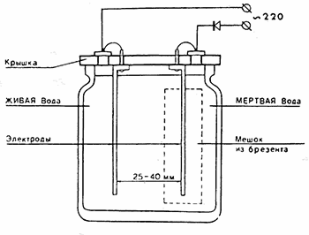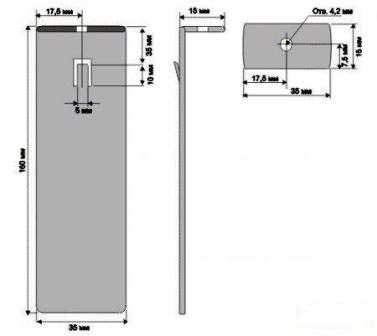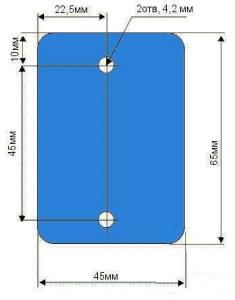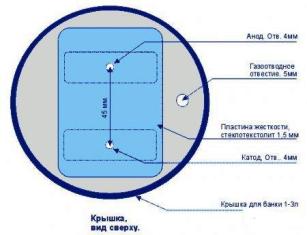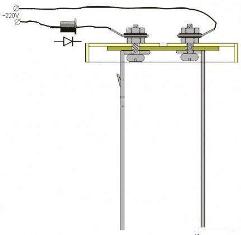Categories: Interesting Facts, Practical Electronics
Number of views: 560464
Comments on the article: 84
Homemade device for producing living and dead water
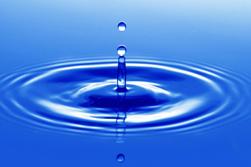 The article gives a brief description of the properties and methods of using activated water. The description of the device of two devices for its preparation is given.
The article gives a brief description of the properties and methods of using activated water. The description of the device of two devices for its preparation is given.
Legends and tales of living water
The healing properties of living and dead water have been known for a very long time. Even in Russian folk tales, the deceased hero-hero was resurrected with the help of dead and living water. Living water is mentioned in many literary sources.
Even in the manuscripts of Ancient Russia of the XIV century. it is mentioned that Alexander the Great during his historical campaign to the ends of the world along the Traverse (Caucasus, Pamir, Tien Shan mountain ranges) discovered a spring with live water. The king ordered a jug of this water to be poured and forced his warrior to guard it: he hoped that if he died, this water would revive him. But the daughter of Alexander, Panorea, seduced the young guard, stabbed him with a knife, drank some water from the jug, and poured the rest onto herself. After that, she became immortal and invisible.
Historical information has been preserved that many Chinese emperors, Roman popes, and other rulers and powers of this world tried to find the elixir of immortality. Entire expeditions were organized to search for the elixir of immortality.
An expedition to find living water, which was learned from local residents - Native American peoples, in the XVI century. organized by the Spanish conquerors. They searched for it on the islands of the Atlantic Ocean and the Caribbean, but they managed to find only a few healing springs and discover the islands of the Antilles archipelago.
Already under Peter I in Russia, one of the tsar’s associates, Field Marshal Yakov Velimovich Bruce (1670-1735), was engaged in the search for living water - the elixir of immortality. After the death of Bruce, according to the will, his body had to be sprinkled with living water. But it turned out that when the magic bubble was opened, the servant simply poured all the water on the floor. Only a small fraction fell on Bruce's hand. Bruce's grave was opened for reburial in the twenties of the XX century. - one of his hands remained imperishable.
All these legends and fairy tales say that our ancestors knew about the existence of living and dead water. The most ordinary water is still not fully understood, modern science still does not know much about it.
 The physicochemical properties of water are very numerous, so it can have a wide variety of effects on the plant and physical world: in some cases, it brings vital energy to plants and organisms, and in others it takes. Under certain conditions, water can have healing properties, do not freeze at very low temperatures, and even glow in the dark.
The physicochemical properties of water are very numerous, so it can have a wide variety of effects on the plant and physical world: in some cases, it brings vital energy to plants and organisms, and in others it takes. Under certain conditions, water can have healing properties, do not freeze at very low temperatures, and even glow in the dark.
In Central Asia, for example, it was noted that the yield of cotton, irrigated with water from an underground source, is 30% higher than when irrigated with irrigation canal. This happens because in the open air, water intensively gives off vital energy simply to the surrounding space. The reason for this is the wind, the sun and much more. Therefore, water from the mountains was delivered to the fields through underground tunnels - kyariz. Thus, some sources contain living water, while others contain dead water.
It is not difficult to answer the question about the sources of dead water. These are swamps, standing lakes and wells, that is, water in all standing bodies of water. Such water, according to ancient healers, is devoid of life-giving energy, therefore it was called “Chi” in their medical language. This water is most suitable for the preparation of healing broths and infusions. According to ancient healers, dead water leads to premature aging, deterioration of the body.
Living water is contained in mountain rivers, waterfalls, it is rain water, especially during a thunderstorm, of course, if the rain is not acidic. Also living water is water from melting glaciers.All these waters lead a person to longevity and are good for health.
Living and dead water for treatment
To get living and dead water it is not at all necessary to look for its natural sources - mountain rivers or swamps. Such water can now be successfully obtained by electrolysis of ordinary water, even at home. Often such water is called activated water.
Research on the properties of living and dead water back in the 80s of the last century was carried out by leading medical institutions of the USSR. But research in this area was carried out, like many others, in an atmosphere of secrecy and most of the results were not advertised and was not accessible to the general public. But, as the folk wisdom says, you can’t hide the sewn in the bag, so the secret reached interested people, - doctors and traditional healers found out about it.
Probably, in this regard, the work of foreign researchers helped more, because there they had similar developments conducted openly, and even in the conditions of the Iron Curtain, their results were available in the USSR. These developments were simply published in the press.
Modern science has proven that living water, also called catholyte, during electrolysis gets negative potential. From this transformation, it has very high regenerative and immunostimulating properties, which enable it to be successfully used in the treatment of many diseases. Even the Pharmacological Committee of the USSR confirmed the unique properties of living and dead water, its absolute harmlessness, both with external and internal use and the possibility of use in the treatment of many diseases.
Dead water obtained during the electrolysis is also called anolyte, because it accumulates near the positive electrode - the anode. The properties of dead water have been known for a long time, thanks to its antibacterial properties, hundreds of people managed to escape from pressure sores and rotting wounds.
Getting living and dead water
Activated water is obtained by electrolysis of ordinary tap water. From the point of view of chemistry, living water has alkaline properties that have a healing effect, and dead water has acidic properties, so it has disinfecting properties. Passing through ordinary water, an electric current changes its internal structure and contributes to the erasure of harmful environmental information.
After treatment with electricity, water is divided into two fractions that have healing properties. In the treatment of the disease, live and dead water are taken in various combinations. For different diseases, these combinations are different, well studied, there are many articles and tables on the treatment of activated water on the Internet.
The first experiments with activated water
 The author of the device for the preparation of living and dead water in our country is considered N.M. Kratov. The history of the device is as follows. In 1981, N.M. Kratov was cured in the hospital for prostate adenoma and kidney inflammation. After more than a month of treatment, the doctors suggested adenoma surgery. He refused such an offer, so he was simply discharged.
The author of the device for the preparation of living and dead water in our country is considered N.M. Kratov. The history of the device is as follows. In 1981, N.M. Kratov was cured in the hospital for prostate adenoma and kidney inflammation. After more than a month of treatment, the doctors suggested adenoma surgery. He refused such an offer, so he was simply discharged.
Just at that time, the son had a wound in his hand that did not heal for more than six months. Tests of the properties of activated water were carried out on it and exceeded all expectations: the wound healed on the second day.
Inspired by success, the author himself began to take living water half a glass a day three times before meals, and soon felt cheerful. Together with an adenoma, a swelling of the legs and radiculitis passed a week later.
To verify the effectiveness of his treatment N.M. Kratov went to the clinic, and the tests showed that he had completely left the disease. On top of that, blood pressure returned to normal.
Over time, to N.M. People began to turn to Kratov for help. During treatment with live and dead water, in just two days, a third-degree burn on a neighbor’s arm was obtained, obtained with boiling water.
For a whole six months the gums of a neighbor's boy were festering, an abscess formed in the throat, and traditional medications did not give the desired result. On the advice of the author of the device, the throat and gum were rinsed 6 times a day with dead water (disinfected), after which they were taken orally by a glass of living water. As a result, in just 3 days, a full recovery came.
Activated Water Treatment Methods
In addition to Kratov, G.D. Lysenko and many more authors. Thanks to their efforts, it became known that with the help of living and dead water, it is possible to cure almost 50 diseases, ranging from sore throat and ending with an ulcer of the twelve - duodenum and stomach. This list also includes common diseases such as flu, colds, runny nose, burns, sciatica, high blood pressure and many others. All this is quite easy to find on the Internet, the treatment methods are also indicated there.
Do-it-yourself living and dead water apparatus
Devices for the production of living and dead water are now easy to find on sale, in any case, the Internet is full of such advertising. But, if you buy such a device and look at its device, you can see that the price paid for such a simple device is quite high. It would be simpler to make it with your own hands, especially since this will require very little materials, time, and the skills of our craftsmen - do-it-yourselfers. A diagram of the device for producing activated water is shown in Figure 1.
Figure 1. Diagram of the device for producing live and dead water.
This diagram shows that the entire device consists of two metal electrodes placed on an ordinary glass jar. Electrodes with screws and nuts are mounted on the lid of the can. One of the electrodes is connected directly, it will be a cathode, and the other is connected through a diode.
With the polarity of connection indicated in the figure, the left electrode is the anode.
Dead water, anolyte, will be released on the positive electrode, so a bag of dense fabric is fixed on the anode to collect it. The fabric should be sufficiently dense, but thin, very suitable for these purposes tarpaulin from gas masks or calico. The criterion for choosing tissue can be considered the passage of air through it. For this purpose, it is enough to attach the tissue to the mouth and try to blow air through it: the tissue resistance should be quite noticeable.
The main parts of the device are electrodes, the dimensions of which are shown in Figure 2.
Figure 2. Electrodes.
The length of the electrodes in the figure is 100 mm. This is true if a half-liter can is used. In principle, the volume of the can can be increased to three liters, then you just need to extend the electrodes, but so that they do not touch the bottom of the can by at least 5 - 10 mm.
As the electrodes, sheet stainless steel with a thickness of 0.8 - 1.0 mm is used. It is better if it is a “food” stainless steel, although some authors say that they themselves even use aluminum electrodes.
The figure shows that the electrode has a U-shaped cut. Such a cut is needed only on the positive electrode - the anode so that you can hang a cloth bag on it to collect dead water. On the other electrode, such a cut will not be required.
The electrodes are attached to the jar using a conventional capron cap as shown in Figure 1. It is known that such caps do not differ in mechanical strength, so that the behavior of the electrodes is not unpredictable, they should be mounted on the cover through a sealing insulating gasket. It can be made of fiberglass, of course, without foil, textolite or any other plastic. The gasket design is shown in Figure 3.
Figure 3. Insulating gasket.
Figure 4 shows how this gasket is installed on the capron lid of the can. Shown are the holes for attaching the electrodes and the hole for the exit of gases.
Fig. 4.
Figure 5 shows the mounting of electrodes and gaskets to the cover.
Figure 5. Mounting the electrodes.
If you use a threaded diode, its thread will mount the positive electrode. Fundamentally, nothing prevents the use of a rectifier bridge instead of a single diode. In this case, the device’s power will simply increase 4 times and, accordingly, the cooking process will accelerate, which is important when using the device systematically.
Activated water preparation
The preparation of living water is quite simple. You just need to fill in the cloth bag with water, fix it on the positive electrode, and then insert it into the jar filled with water. The water in the jar should not reach the edges and be slightly lower than the upper edge of the cloth bag. More precisely, the level of pouring water into the jar is established experimentally.
The preparation of living water takes no more than 5 - 10 minutes. After this, it is necessary to remove the electrodes from the can and very carefully so as not to mix the fractions obtained, pour dead water from a cloth bag into a separate bowl.
This is “neat” - perhaps the most important drawback of the described construction, of course, if you do not think about the possibility of electric shock. Therefore, all the manipulations, from pouring fresh water to receiving live and dead, it is better to do by turning off the device from the power outlet.
In addition to the design already described, it is possible to recommend the design of the device without a cloth bag for manufacturing. In this case, you will need two separate containers, only without a neck, like cans, but with straight sheer edges. The design of the electrodes remains unchanged, only they will have to be installed separately for each container.
In order to ensure electrical contact between these banks, they should be connected with a cotton rope, wound in gauze. In this case, the tow should be pre-moistened with water. Such a tourniquet will connect the banks electrically and provide a path for the passage of ions between the banks. Thus, living water will accumulate in one bank, and dead water in another. Therefore, after the end of the process, it is enough to simply turn off the installation from the network and get catholyte and anolyte just from different cans, with the same capacity.
The entire structure, both this and the previous one, can be connected to the network not directly, but through a light bulb with a power of about 15 watts. These are used in refrigerators and sewing machines. In the event of a short circuit of the electrodes, it will act as a fuse, and in the case of normal operation, an indicator: at the beginning of the process, the lamp will shine brightly, closer to the end, the brightness will drop significantly, after which the lamp will completely go out. This is a signal that activated water is ready.
In the process of preparing water, scale will form on the electrodes and on the bank itself, which can be removed with a solution of citric or hydrochloric acid. After this, the jar should be thoroughly washed.
Do not pour water directly from the tap into the appliance. It is better if you let the water stand for at least 5-6 hours, so that chlorine leaves it, otherwise hydrochloric acid may form. It is very good if you filter the tap water through any household filter and boil it.
Boris Aladyshkin
See also at e.imadeself.com
:

